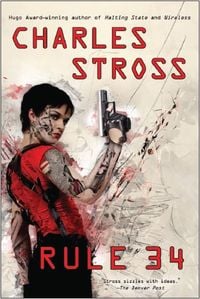 Charles Stross’s latest science fiction novel, Rule 34, includes a whole lot of deep thinking on the implications of widespread 3D printing. We’ve discussed some of these issues before, but Stross’s novel proposes another more aggressive solution: forbidden shapes. In other words, 3D printers could be rigged to detect and prevent the production of certain objects deemed illegal. The printers may even report you for attempting such, too.
Charles Stross’s latest science fiction novel, Rule 34, includes a whole lot of deep thinking on the implications of widespread 3D printing. We’ve discussed some of these issues before, but Stross’s novel proposes another more aggressive solution: forbidden shapes. In other words, 3D printers could be rigged to detect and prevent the production of certain objects deemed illegal. The printers may even report you for attempting such, too. This isn’t without precedent; for many years common office photocopiers have had secret built-in code to detect the copying of currency. As copiers became more capable, they also became more capable of counterfeiting. Could a similar approach be attempted for 3D printers? Will objects gradually become more complex in a likely fruitless attempt to slow down copying?
We think someone will try to put such constraints on 3D printers, but ultimately they will fail. Why? Because we think there are a heck of a lot more contraband objects than there ever could be 2D paper contraband. Aside from currency and perhaps bogus University Diplomas, there’s not that much really bad stuff you can print on paper. Objects, on the other hand, are infinite in their variety.
What’s a bad object? Well, weapons for one – and there are many kinds of those. Bomb parts, delivery mechanisms, etc. could also fall onto the prohibited list. But many of those so-called “bad” objects could be used for good as well as evil. Could the authorities make us live in a world of only dull plastic knives? We can imagine life as if one were always onboard a secure airplane. Not a pleasant thought. Therefore, we can’t see this succeeding.
Cory Doctorow expresses his thoughts on this matter in a recent Make article. He writes:
In Stross’ world, as in our own, the regulatory response is to build devices that have internal snitches that check to see if their owners are running naughty unlocking programs. And in Stross’ world, as in our own, the need to prevent the dissemination of snitchware countermeasures leads to widespread surveillance and censorship of the internet.And in Stross’ world, as in ours, none of this actually works worth a damn at stopping bad guys. Instead, it creates a vicious cycle of more surveillance and more control to overcome the failings of the current round of censorship and surveillance.
Oh and why “Rule 34”? Urban slang says: “If it exists, there is porn of it. No exceptions.” And that’s exactly the case with 3D printers, too.

